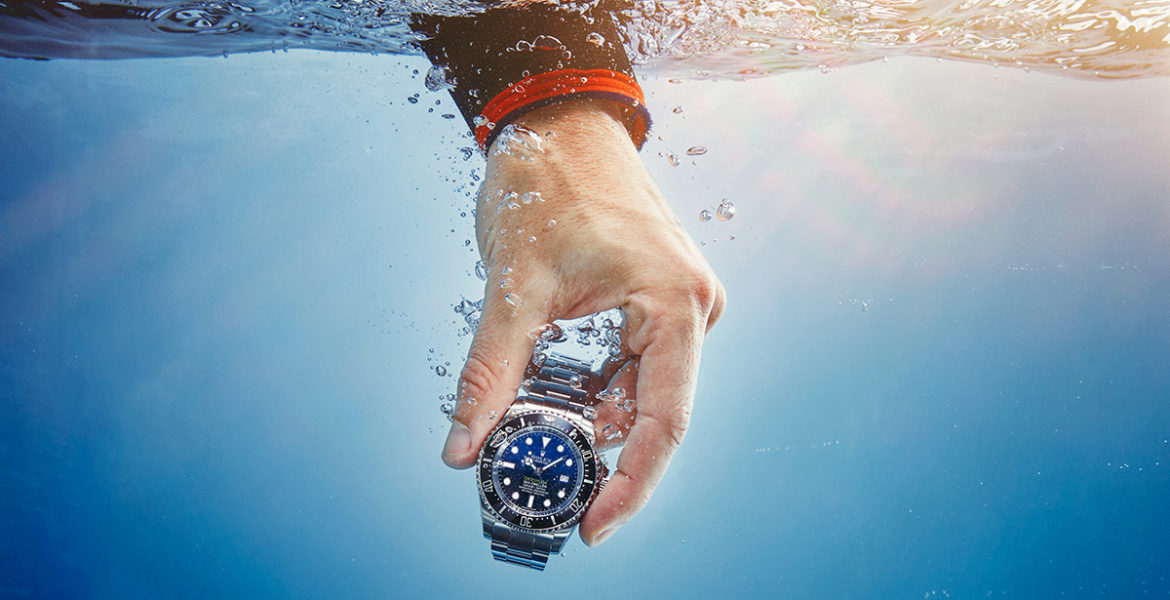
Everything you need to know about the water resistance of your watch

How resistant is water resistant? A nasty surprise for many: Even a waterproof watch can be damaged by water. So what exactly is allowed? We show you what you have to pay attention to so that your watch does not stop.
The biggest enemy of a movement
Watch connoisseurs know that humidity is one of the greatest enemies of a movement. A waterproof case offers optimum protection so that you can shower, bathe or even swim with your favourite piece on your wrist without any worries. Unfortunately, even such a watch does not always keep tight. Time and time again, watches with a water damaged movement are sent to the CHRONEXT workshop. "After the shower, the watch stopped, but it is water resistant to 30 metres", we discover in the enclosed message.
How does such water damage occur? Which water contact does your watch allow? How does the watertightness remain intact? We'll clear it all up for you!
Fear no water: How tight is watertight?
If you take it literally, no watch is 100% waterproof. In ocean depths, all ordinary wristwatches will give way to the water pressure. So what is a waterproof watch? As is so often the case in Germany, there is also a DIN standard for this. 30 minutes in 1 metre water depth and 90 seconds in 20 metres water depth, a watch should remain functional in order to be classified as water resistant according to DIN 8310. Although such a watch is resistant to rain and drops of water, it could still let water through when swimming - in fact, it is only partially waterproof.
DIN points out that water resistance is not a permanent characteristic - the water resistance specified by the manufacturer is much more a condition that was taken up during the test of the watch. This makes the regular inspection, during which the water resistance of the watch is checked, all the more important. However, most manufacturers of high quality watches give a guarantee of two years and thus also guarantee an existing water resistance within this period.
Whether sunbathing by the sea or on your next dive: Discover three luxury watches for that plunge in cool water
Water resistance up to 100-200 metres: Tudor Black Bay

Water resistance up to 300-600 metres: Omega Seamaster Planet Ocean

Water resistance up to 1000 metres or more: Rolex Sea-Dweller

An oyster on the wrist: The waterproof watch case
What makes a waterproof watch? Screwed case and crown as well as solid seals are indispensable elements. The first waterproof wristwatch is believed to be the Rolex Oyster, introduced in 1926. "Oyster" describes the concept of a screwed case: Like an oyster, the bezel and case back are hermetically screwed to the middle part of the watch on both sides.
The crown is a weak point in the construction, as the water can penetrate directly into the movement. Manufacturers solve the problem by sealing the crown and usually screwing it into the case. The same principle is applied to the chronograph pushers.
For decades, there has been fierce competition for the best diving watch and every year the manufacturers surprise with new record depths, innovative seals and unusual solutions. We can only be pleased about this inventive spirit, but many of the innovations are only used to a limited extent in everyday life.
30 metres or 3 bar? The true water resistance of your watch
30 metres is not the same as 30 metres. If the manufacturer writes that the watch is water resistant to 30 metres, this simply means that the model can withstand the theoretical pressure at this water depth - 3 bar. A bar corresponds to the pressure of one kilogram on a square centimetre large surface, if the force acts vertically on this surface. In practice, however, the pressure in the water varies enormously. As a result of arm movements or jumps, a pressure of more than 3 bar can occur and thus also the risk of water damage. Therefore, a watch that is water resistant to 50 metres should not be worn when swimming.
Our graphic gives you a reliable overview of the different levels of watertightness and clarifies what is permitted and what should be avoided.

Take the right measures: How do I care for my waterproof watch?
Keep your watch on in the rain or water: A waterproof watch is undoubtedly a reliable companion in everyday life. But like any mechanical work, it also requires special care and attentive handling. We have summarised the most important tips for you:
Never wind the crown underwater or on a wet watch. You should also not operate the chronograph pushers, if present, underwater or on a wet watch.
Before each water contact, check that the crown and pushers are firmly screwed together.
If water or condensation occurs under the glass, the watch should be checked by a professional watchmaker as soon as possible so that damage can be minimised.
Perfumes, creams and often also salt water attack the seals of the watch - it is best to take off your watch in the appropriate situations. Strong heat and temperature fluctuations also have a negative effect on the watch.
You always want your darling on your wrist? Regular maintenance ensures that the seals are replaced in good time. Have your watch checked and overhauled by a professional watchmaker. If the watch comes into frequent contact with water, it should be checked every 1-2 years. In our workshop we can check and optimise both the water resistance and the accuracy of your watch.